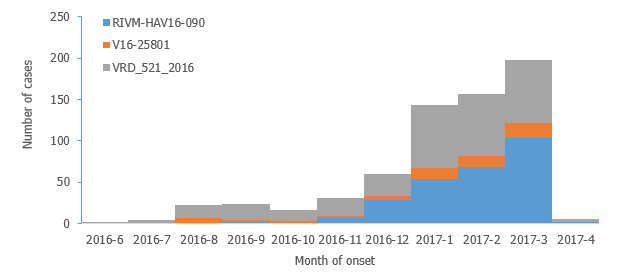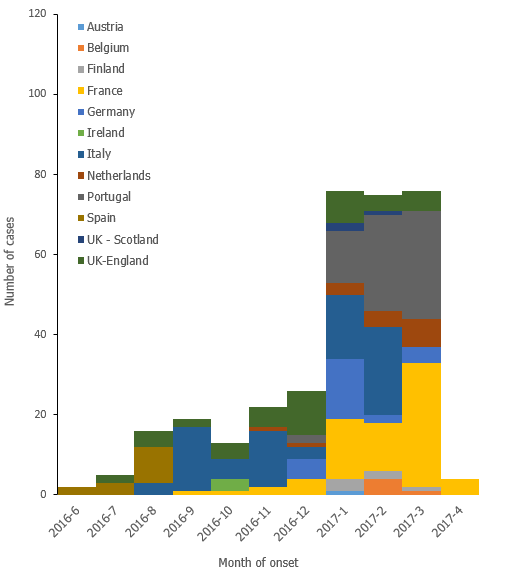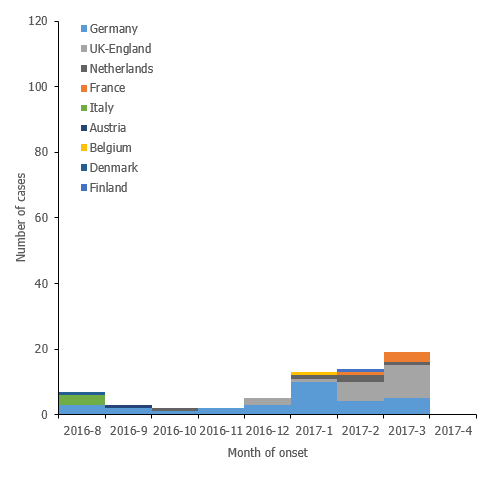Epidemiological update: Hepatitis A outbreaks in the EU/EEA mostly affecting men who have sex with men
Since the last ECDC rapid risk assessment, which was published on 24 February 2017, 10 EU Member States (Austria, Belgium, Denmark, France, Germany, Italy, the Netherlands, Portugal, Sweden and the United Kingdom (Public Health England and Health Protection Scotland) reported 387 new confirmed cases of hepatitis A, with one of the strains matching the three clusters currently circulating in the EU.
In total, 674 confirmed cases have been reported as associated with these outbreaks since 1 June 2016. Of the 665 cases with available information on gender, 531 (95%) are in males; of the 622 of these with available information on age, 558 (90%) are between 18 and 50 years of age. The majority of the cases with available information on sexual orientation (n=353 – 83%) are men who have sex with men (MSM). The number of new confirmed cases associated with these outbreaks has been consistently increasing since summer 2016.

Figure 1. Number of confirmed hepatitis A cases, by month and genetic clusters associated with the EU outbreaks, June 2016–April 2017 (n=674; nine cases were reported without month of onset or proxy date, i.e. month of sampling or month of receipt by reference laboratory)
Cluster VRD_521_2016
The largest number of reported cases is associated with cluster VRD_521_2016 (n=336), which was first reported by the UK in December 2016. Forty-three cases (20%) of those with available travel history travelled abroad during the incubation period; of the 35 travelling in the EU, 18 travelled to Spain.

Figure 2. Number of confirmed hepatitis A cases infected with strain VRD_521_2016, by month and reporting country, EU, June 2016–April 2017 (n=336; two cases were reported without month of onset or proxy date, i.e. month of sampling or month of receipt by reference laboratory)
Cluster RIVM-HAV16-090
A total of 286 cases are associated with the cluster RIVM-HAV16-090, which was first reported by the Netherlands in October 2016. Sixty-three cases (29%) of those with available travel history travelled abroad during the incubation period; of the 49 travelling in the EU, 27 travelled to Spain and five to Germany.

Figure 3. Number of confirmed hepatitis A cases infected with strain RIVM_HAV16-090, by month and reporting country, EU, June 2016–April 2017 (n=278; two cases were reported without month of onset or proxy date, i.e. month of sampling or month of receipt by reference laboratory)
Cluster V16-25801
Seventy cases are associated with the cluster V16-25801, which was first reported by Germany in January 2017. Ten cases (20%) of those with available travel history travelled abroad during the incubation period; of these, seven travelled within the EU.

Figure 4. Number of confirmed hepatitis A cases infected with strain V16-25801, by month and reporting country, EU, June 2016–April 2017 (n=70; five cases were reported without month of onset or proxy date, i.e. month of sampling or month of receipt by reference laboratory)
Assessment
European hepatitis A outbreaks mostly affecting MSM are rapidly spreading and are likely not to have reached their peak yet. Spain and Italy were reported as two of the most affected countries in the latest ECDC rapid risk assessment. Most of the sequencing results from these countries, particularly from Spain, are still pending.
The reporting of confirmed cases provides a good indication of the outbreak dynamics.
The definition of confirmed cases is based on viral RNA sequencing, and only a minority of EU countries, sequence a sufficiently large proportion of strains and in a timely fashion. Due to the challenges with regard to complete and timely reporting of sequencing results, the current figures are a large underestimation of the true extent of these outbreaks
The conclusions of the ECDC rapid risk assessment remain valid.
Actions
ECDC continues to monitor this event and supports a European study which aims to describe the full extent of the outbreaks and identify possible risk factors and characteristics independently associated with the three current clusters.




